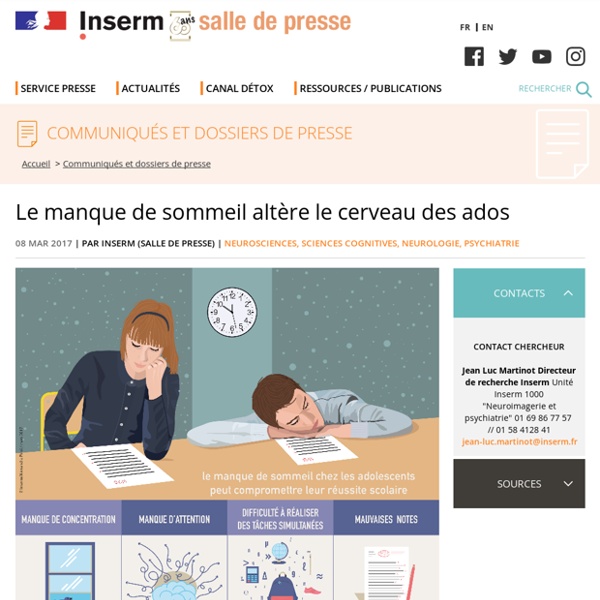Le manque de sommeil altère le cerveau des ados
Sleep habits, academic performance, and the adolescent brain structure Anna S. Urrila1,2,3, Eric Artiges1,4, Jessica Massicotte1, Ruben Miranda1, Hélène Vulser1, Pauline Bézivin-Frere1, Winok Lapidaire1, Hervé Lemaître1, Jani Penttilä1, 5, Patricia J Conrod6, 7, Hugh Garavan8, the IMAGEN consortium, Marie-Laure Paillère Martinot1, 9, and Jean-Luc Martinot1, 10* 1 Institut National de la Santé et de la Recherche Médicale, INSERM Unit 1000 “Neuroimaging & Psychiatry”, University Paris Sud – Paris Saclay, University Paris Descartes - Sorbonne Paris Cité, 97 Bd de Port Royal, 75014, Paris, France. 2 National Institute for Health and Welfare, Department of Health, Unit of Mental Health, P.O. Box 30, 00271 Helsinki, Finland. 3 University of Helsinki and Helsinki University Central Hospital, Department of Psychiatry/ Adolescent Psychiatry, P.O.
https://presse.inserm.fr/le-manque-de-sommeil-altere-le-cerveau-des-ados/27478/
Related: Psychologie cognitive
• Activité cérébrale et hygiène de vie
Sur les intelligences multiples de Gardner
Frames of Mind: The Theory of Multiple Intelligences (Basic Books, 1983) Multiple Intelligences: The Theory into Practice (Basic Books, 1993) Intelligence Reframed: Multiple Intelligences for the 21st Century (Basic Books, 1999)
Inserm - La science pour la santé
Les pathologies liées au sommeil rassemblent à la fois des troubles spécifiques du rythme du sommeil et des affections d'origines diverses qui se manifestent lors du sommeil : Les insomnies Il n'existe pas une, mais des insomnies : certaines sont ponctuelles, d'autres chroniques. Certaines sont caractérisées par des difficultés d’endormissement, d'autres par des réveils nocturnes ou par une sensation de sommeil non récupérateur. Elles se distinguent également par la nature de leurs facteurs déclenchants : facteurs cognitifs ou somatiques internes, ou facteurs extérieurs perturbant le déclenchement ou le maintien du sommeil (hygiène de vie, lumière, utilisation tardive d'écrans ou pratique tardive du sport, prise de certains médicaments…).
L’impact inquiétant des écrans sur votre sommeil
Au laboratoire de chronobiologie de Bâle, en Suisse, trois volontaires sont ici pour dormir. L’expérience : l’un se couche avec un livre, un autre avec une tablette, le dernier avec une tablette et d’étranges lunettes. Elles bloquent les rayons bleus qui proviennent de l’écran de la tablette.
Internet use in class tied to lower test scores
Warning: Surfing the internet in class is now linked to poorer test scores, even among the most intelligent and motivated of students. Michigan State University researchers studied laptop use in an introductory psychology course and found the average time spent browsing the web for non-class-related purposes was 37 minutes. Students spent the most time on social media, reading email, shopping for items such as clothes and watching videos.
What every teacher should know about ... memory
There is a wealth of psychology research that can help teachers to improve how they work with students – but academic studies of this kind aren’t always easy to access, or to translate into the realities of classroom practice. This series seeks to redress that, by taking a selection of studies and making sense of the important information for teachers. No one study or journal can provide a definitive answer, but they can help offer some guidance.
Cone of learning or cone of shame?
I'm sure you've seen a figure like this. It is variously called the "learning pyramid," the "cone of learning," "the cone of experience," and others. It's often attributed to the National Training Laboratory, or to educator Edgar Dale. You won't be surprised to learn that there are different versions out there with different percentages and some minor variations in the ordering of acCertainly, some mental activities are better for learning than others. And the ordering offered here doesn't seem crazy.
The problem with ‘reading along’
It has become an unwritten law of teaching that when reading aloud to students, the teacher must ensure students are reading along in their own copy of the text. This is, I contend, a bad idea. To understand why we need to consider working memory in some detail.
"How to Study Less and Learn More": Explaining Learning Strategies to our Students
Because cognitive science gives us such good guidance about learning, we want to share that information with our students. “Study THIS WAY!” we cry. “Research says so!”
A model for the learning process. And why it helps to have one.
One of the most powerful ideas I’ve engaged with recently is using a diagram to visualise a shared model of the learning process; using it to get a feel for how learning works in general but also to identify reasons for why it can sometimes not happen. This is the diagram I have in my Rosenshine Principles book, courtesy of Oliver Caviglioli: I’ve found it massively helpful as a focus during CPD as we’ve explored a range of interlocking, overlapping ideas:
Related:



